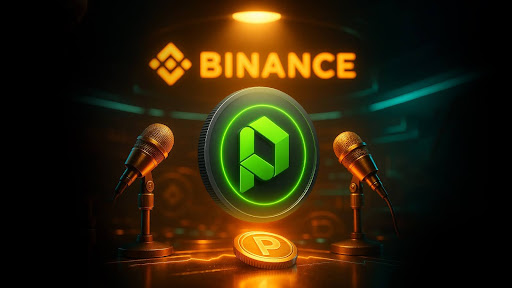The recent Binance Live Q&A featuring PayDax Protocol (PDP) has turned what was a promising DeFi presale into one of the most closely watched early-stage projects in crypto.
Within hours of the event, PayDax recorded a sharp increase in the PDP presale participation, as both retail and institutional investors responded to the growing visibility surrounding the protocol.
For many, the Binance spotlight served as validation of what early supporters already believed—that PayDax is building one of the few blockchain ecosystems with the potential to operate like a real financial system, not a speculative experiment.
Binance Exposure Brings Credibility and Confidence
Projects rarely make it onto Binance’s stage without demonstrating genuine merit. The Q&A session with PayDax leadership offered a rare look into the project’s inner workings and long-term vision.
The PayDax rep discussed how the protocol is not just another DeFi platform, but a structural redesign of how lending, borrowing, and insurance can function in a trustless environment.
That transparency appeared to resonate. Data from the presale site showed a visible uptick in wallet connections shortly after the live session, with over 20% of Stage 1 tokens now acquired in less than two weeks.
PayDax Protocol (PDP): The Model Behind the Momentum
While Binance’s visibility helped bring attention, the underlying model is what’s driving sustained inflows. PayDax was built out of frustration with a global financial system where profit margins overwhelmingly favor institutions rather than the individuals generating the value.
In traditional finance, ordinary savers earn less than 1% on deposits while banks re-lend that same money at 10–20%. Borrowers face endless friction, from paperwork and collateral restrictions to outright exclusion based on geography or credit history. Insurance, too, is monopolized by a handful of institutions that quietly shift risk to consumers through opaque fees.
PayDax Protocol (PDP) re-engineers that entire cycle by creating a peer-to-peer financial framework where savers, borrowers, and insurers all interact directly through smart contracts. It’s not a theoretical fix, but now a functioning model designed to redirect the same profit flows that banks capture back to the users themselves.
Lending: Real Yield, Not Empty Promises
In the PayDax economy, lending isn’t about chasing volatile token rewards. It’s about participating in real value exchange.
A saver who deposits $5,000 can earn up to 15.2% APY, more than ten times what a traditional savings account might offer. But beyond the numbers, the impact runs deeper. The yield doesn’t rely on inflationary emissions or speculation; it comes directly from borrowers within the ecosystem.
For users in countries where savings rates barely outpace inflation, PayDax represents a pathway to true capital growth. For others, it’s a chance to become the lender instead of being dependent on one.
Borrowing: Borderless Access to Capital
PayDax Protocol (PDP) also transforms how borrowing works. Instead of waiting for institutional approval or passing arbitrary credit checks, users can unlock liquidity instantly by pledging cryptocurrency or tokenized real-world assets (RWAs).
That means a small business owner in Lagos, a freelancer in Manila, or a trader in Buenos Aires can all access global liquidity under the same conditions. Borrowers can choose their own loan-to-value (LTV) ratio, from 50%, 75%, 90%, or 97%, depending on their needs and collateral type.
A Bitcoin holder can lock up 1 BTC worth $100,000 and receive a stablecoin loan in USDT/USDC, without selling their appreciating asset. Meanwhile, through partnerships with Sotheby’s and Brinks, users can tokenize real-world items like watches or gold, verified by Chainlink Oracles for live market pricing.
Insurance: The Foundation of a Sustainable Economy
The final piece of the PayDax framework is its insurance layer through the Redemption Pool. Here, community members act as insurers, staking funds to underwrite loans and earning up to 20% APY in return.
If a borrower defaults, the Redemption Pool automatically covers the lender’s loss, maintaining systemic trust without needing a centralized guarantor. This mechanism closes the financial loop, creating a self-sustaining ecosystem where every participant (lender, borrower, or insurer) is rewarded for contributing to stability.
It’s a design that mirrors the structure of traditional banking but decentralized it and redistributes its benefits to the people powering it.
Trust and Transparency Win the Market’s Attention
What stands out most about PayDax is its credibility-first approach. The team, led by CEO Werner Van Staden, is fully doxxed and verifiable, an uncommon level of openness in the presale market. The project’s smart contracts have also been audited by Assure DeFi, providing independent assurance of security and performance.
These details may seem procedural, but for presale investors, they represent a clear departure from the anonymity that often plagues early-stage crypto. When paired with a working economic model and public exchange visibility, that transparency becomes a growth driver.
PDP Presale: Why Investors Are Moving Early
At Stage 1 PDP presale pricing of $0.015 per token with a 25% bonus for using the PD25BONUS code, PayDax remains at its lowest entry point. Analysts see it as a calculated early-stage opportunity, similar to the early days of top-performing DeFi tokens like Solana (SOL) before they gained traction on centralized exchanges.
Already, PayDax has seen over 20% of the Stage 1 supply scooped up as investors position for the highest upside. However, for interested investors on the sidelines, this only means that the entry window will soon disappear. With 7,000% projected gains in Q4 alone, spectators believe Stage 1 will be over in the coming days.
Join the Paydax Protocol (PDP) presale and community:
Website: https://pdprotocol.com/
Telegram: https://t.me/PaydaxCommunity
X (Twitter): https://x.com/Paydaxofficial
Whitepaper: https://paydax.gitbook.io/paydax-whitepaper
Disclaimer: This is a paid post and should not be treated as news/advice. LiveBitcoinNews is not responsible for any loss or damage resulting from the content, products, or services referenced in this press release.




